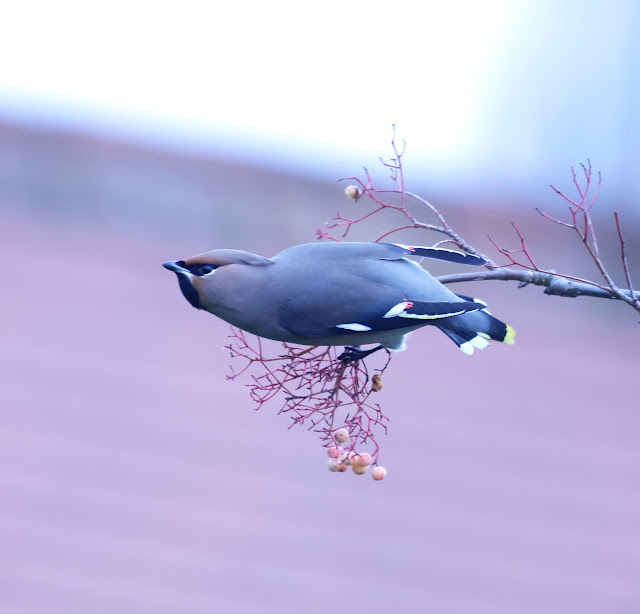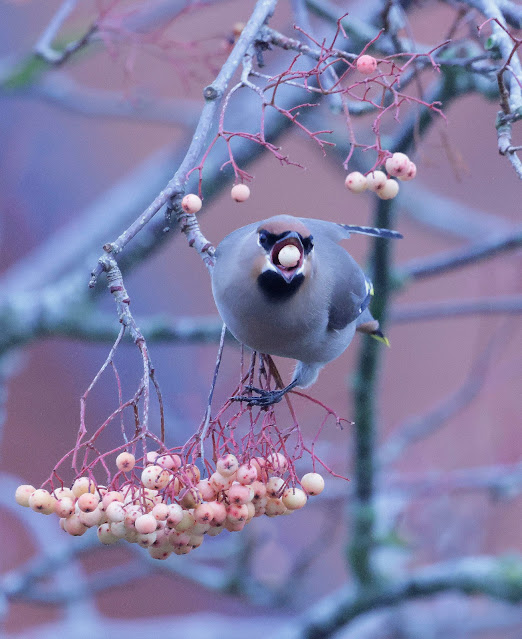This autumn they arrived in force with flocks exceeding a hundred reaching the coasts of northern Scotland, which slowly worked their way southwards, splitting into smaller flocks as they did so.Like the invading vikings of old these small flocks roved the land, initially to the east, then ranging wider but pillaging only berries, their chosen source of sustenance. These flocks and single birds can turn up randomly, anywhere there are suitable berries - rowan and cotoneaster being most favoured and birders the length of Britain feel a fizz of excitement at the prospect of an unexpected encounter with these charismatic and beautiful birds roaming our countryside.
'Countryside' is maybe misleading as the Waxwings are more often to be located in urban and suburban locations as this is where the berries are more likely to be found, on trees and bushes planted as landscaping in industrial estates, parks and gardens. The birds, once they locate a suitable berry source, are often loathe to leave and will remain until all the berries are consumed. Being virtually fearless and very obvious when they descend in a fluttering mass onto a berry tree or bush they are invariably noticed and catch the general public's imagination just as much as that of birders.
It was only today that I managed to catch up with a group of nine Waxwings that have taken a fancy to some ornamental rowan trees in a small patch of greenery known as Naunton Park in the town of Cheltenham,where they have been present for almost a week, delighting birders, photographers and public alike.
The small park consists of grass and mature trees with a number of flower borders and smaller ornamental trees. Surrounded by housing it is understandably popular with the public who use it for relaxation and dog walking..The Waxwings show no sign of being troubled by the constant passage of humanity, even the dogs fail to trouble them and one can get very close to them at times, even with a dog!
Having returned only yesterday from our usual Christmas and New Year break in Scotland I wasted no time in making a forty minute drive from our home to Naunton Park in Cheltenham.
Crossing a dank and waterlogged Cotswolds on a day which promised alternate cloud and weak spells of sunshine, I encountered only light traffic and duly arrived at Naunton Park at just on nine. I was able to park in a road right next to the park and was surprised to see only two other birders standing near to one of the larger mistletoe festooned trees that guard the perimeter of the park.
Joining them they pointed out a group of fifteen birds perched at the very top of another similarly tall tree.Were there more waxwings now than nine? I discovered that the group consisted of mainly Starlings and in amongst them and not looking dissimilar were four Waxwings rather than the expected nine.
I settled into the accepted routine one adopts with Waxwings, whereby you wait while they perch on high well out of harms way until they decide to descend to gobble berries from the berry tree of their choice. The half dozen trees in question, still well laden with pale orange berries rather than the expected red ones, encircled a crossroads of footpaths. .
For twenty or so minutes the Waxwings perched on their lofty perches. The Starlings departed but the Waxwings remained. It was now surely a formality to see when they would come down to feed but it did not quite work out that way. These were wild birds, unpredictable and not guaranteed to perform as expected. Whilst checking my camera, my attention diverted, they flew off and gave me and my two companions the slip.We had no idea where they had gone but one thing was for certain they were no longer in the park.
This was naturally disappointing, unexpected and concerning but despite checking every large tree in the vicinity there was no sign of them. All I could do was hope they might return and soon.Yesterday there was only one report of them and that said they had flown off at 10am. There were no further reports but that could well have been because no one bothered to report them during the rest of the day. Half an hour later it was not looking good and a creeping doubt began to assert itself.More people arrived and like me stood around, looking rather glum.
It was with some relief that on one of my periodic checks of the large trees I discovered they had returned to perch, typically, again at the very top of the largest tree.
They remained in the tree for another long period and then one flew lower to a smaller tree.I prepared for action and moved towards the berry trees and in a few minutes the remaining three joined their bolder companion and then all four flew to the berries.
The quiet, patient vigil for both photographers and birds now descended into a frenzy.The Waxwings modus operandi was to frantically gobble as many berries as possible in as short a time as possible before fleeing back to the sanctuary of their favourite tall tree. We the assembled photographers and birders, it is hard to differentiate these days, became equally frenzied as we endeavoured to make the most of this all too brief window of opportunity and get that clear shot, unencumbered by twigs and branches, of the restless hyperactive birds which were constantly and frustratingly, forever changing position as they sought that particular berry that took their fancy.
It is all over in less than a couple of minutes.The birds fly back to their tall tree while we check the images taken in that frantic minute or two, hoping one or two may be acceptable but often they are not up to scratch so one settles to await the next assault on the berries by the Waxwings.Sometimes it can be a long wait but they will eventually descend.
The four Waxwings having gorged themselves on the berries then spent a very long time sat in a smaller tree right above our heads and seemed in no hurry to revisit and feed on the berries or return to the taller trees.One commenced preening and this proved infectious as soon all four were at it, tweeking flight feathers and digging into soft breast feathers, stretching wings and tails, before they settled to remain quiet but vigilant above us.
I looked to the sky and as I did another five Waxwings flew in to join the original four. So now there were the usual nine.
Where these five had been was anyone's guess, presumably they had found another source of berries but for now they seemed content to rejoin the other four and remain as one flock.
Adam, an Oxonbirder colleague, joined me and we stood and admired the group which then did the decent thing and dropped down onto the berries, precipitating another hectic two minute togging session before the birds flew back up into the smaller tree.
Now, their behaviour changed and rather than as one flock, only one or two at a time took it in turns to feed, presenting us with ample opportunities to take photos of them.
All nine eventually returned to perch in the large tree and started trilling, a thin sibilant call that often signals the birds impending departure.It went on for a minute and then all the birds flew as a group high and away from the park.They were gone.
A local birder told us they would not be back for an hour as this was what they did yesterday.
Fancy a coffee Adam?
Why not.
We walked down a couple of adjacent streets to arrive on a main thoroughfare where we found a very pleasant cafe which supplied us with coffee for me and tea for Adam.
Suitably refreshed we returned to find the Waxwings had also returned and were being photographed and admired by around twenty people.We joined them and now the birds seemed more hungry and came down to the berries regularly, again never remaining long, a matter of a minute or two but there was a constant 'tooing and froing' of Waxwings, so everyone was happy.
Adam had to return to Oxford so said goodbye and I was on my own again. A couple of Redwings, also from north of our shores but unlike the Waxwings regular winter visitors, commenced visiting the berry trees but always departed when the Waxwings descended.
Waxwings are extremely acrobatic when plucking at the clusters of berries. They cling like feathered baubles to the extremities of the rowans, grasping a berry festooned stem, tilting over or hanging downwards, sometimes overbalancing as they stretch to pull off the berries.
They do not necessarily swallow all the berries while in the berry tree but sometimes will fly with one in their bill, back to the top of the large tree.
Towards lunchtime the flock was now once again back in their favourite tall tree. The trilling started again just before one o' clock and, as before, the birds flew as a flock high and away out of sight over the surrounding roof tops.
I had thoroughly enjoyed my morning and felt fulfilled by my Waxwing encounter. so decided that now was as good a time as any to leave. It is only January after all and Waxwings will be around for at least three months yet.They are still being reported from widespread locations so there is plenty of time to catch up with some more. Maybe Oxfordshire will be blessed with their presence. A few have been seen in the county but have not remained.
I live in hope.


.jpg)
.jpg)
.jpg)
.jpg)
.jpg)




























No comments:
Post a Comment